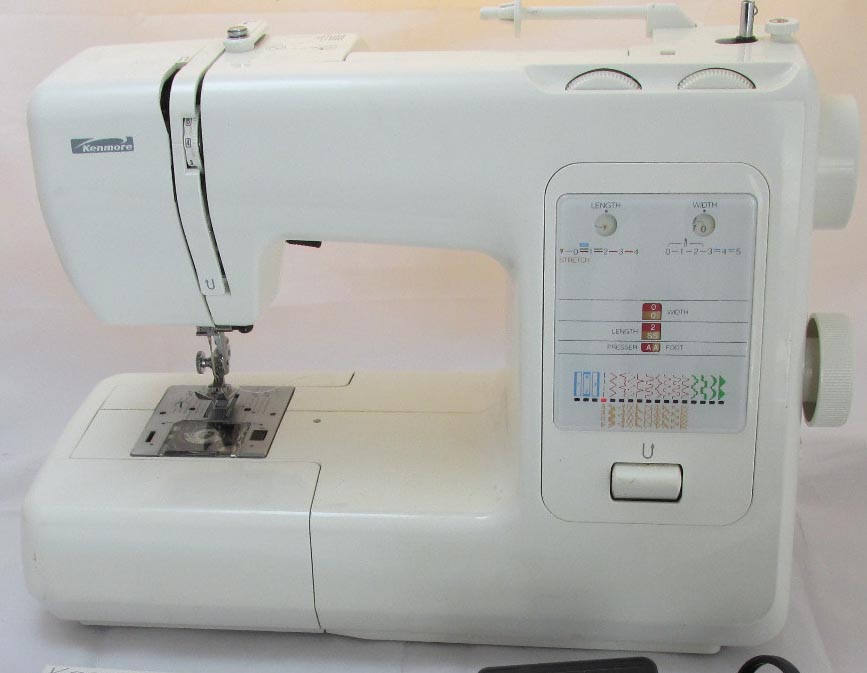Kenmore Sewing Machine Troubleshooting: Expert Tips
Have you ever sat down to work on your latest sewing project, only to find that your trusty Kenmore sewing machine refuses to cooperate? It’s frustrating, isn’t it?
You might feel stuck, ready to toss your machine aside. But before you do, let’s explore some simple troubleshooting steps that could get your Kenmore sewing machine back to stitching perfectly. You don’t need to be an expert to resolve these common issues.
In fact, with a little guidance, you’ll be able to identify problems and solve them quickly. So, grab your machine and let’s dive into some easy solutions that could save you time and keep your sewing projects on track. Feel the excitement of getting your sewing machine working smoothly again as you discover tips that really work!
Common Issues
Kenmore sewing machines often face tension issues, threading problems, and bobbin glitches. Proper maintenance and timely adjustments can solve these common troubles, ensuring a smooth sewing experience. Regular cleaning helps prevent fabric jams and enhances machine longevity.
Owning a Kenmore sewing machine can open up a world of creativity, but like any tool, it may sometimes face hiccups. Understanding the common issues that arise can save you both time and frustration. Let’s dive into some typical problems and how you can tackle them effectively.Thread Problems
Thread issues are a frequent concern for Kenmore sewing machine users. If your thread keeps breaking, it might be due to incorrect threading. Carefully re-thread your machine, ensuring the thread flows smoothly through all guides. Tension settings could also be the culprit. Test different tension settings on a scrap fabric to find the sweet spot. Is the thread bunching underneath? Check the bobbin placement and make sure it’s in the right direction.Needle Issues
Needle problems can disrupt your sewing project significantly. A bent or dull needle will often skip stitches or snag fabric. Regularly replace your needle—after every project or about every 8 hours of sewing. The needle type matters too. Using the wrong needle for your fabric, such as a universal needle for thick denim, could cause issues. Always match the needle size and type to your fabric for the best results.Machine Jamming
Machine jamming is a common frustration. It often happens when lint and fabric bits accumulate inside the machine. Regular cleaning is vital to prevent jams—remove the needle plate and clean the area with a small brush. Sometimes, jamming occurs due to improper bobbin placement. Ensure the bobbin is correctly inserted and that it’s wound evenly. Have you ever noticed your machine jam after sewing thick seams? Slow down and gently guide the fabric to avoid this issue. By addressing these common issues, you can keep your Kenmore sewing machine running smoothly. What challenges have you faced with your sewing machine? Tackling them head-on can lead to a more enjoyable sewing experience.Basic Maintenance
Basic maintenance of your Kenmore sewing machine is essential for ensuring its longevity and peak performance. Neglecting regular upkeep can lead to various issues, hindering your sewing projects and costing you time and money. By dedicating a little time to maintenance, you can keep your machine running smoothly and efficiently, just like new. Let’s dive into some basic maintenance tasks that every Kenmore sewing machine owner should know.
Cleaning The Machine
Keeping your sewing machine clean is crucial to its functionality. Dust, lint, and fabric scraps can accumulate inside, affecting its performance. Use a small brush or a vacuum attachment to gently remove debris from hard-to-reach areas. A clean machine not only runs better but also extends its lifespan.
Don’t forget to clean the bobbin case and feed dogs. These areas tend to gather a lot of lint and can cause stitching issues if not attended to. A clean machine is a happy machine. Have you ever noticed how smoothly it runs after a thorough cleaning?
Oiling Parts
Oiling your Kenmore sewing machine is a simple yet vital task. It keeps the moving parts functioning smoothly and prevents wear and tear. Always use sewing machine oil, as other types can damage your machine.
Refer to your manual for specific oiling points. A little oil goes a long way, ensuring your machine runs quietly and efficiently. Do you remember the first time you oiled your machine and noticed how much quieter it was?
Replacing Needles
Replacing needles regularly is a small task with a big impact. A dull or bent needle can cause skipped stitches and damage your fabric. Make it a habit to change needles after every large project or when you notice stitching issues.
Always use needles suited for your fabric type. A simple needle replacement can make your sewing smoother and prevent frustrating mishaps. Have you ever thought a project was doomed, only to realize it was just a needle issue?
By incorporating these basic maintenance tasks into your sewing routine, you can ensure your Kenmore sewing machine remains in top condition. Regular upkeep is a small investment for a smooth sewing experience. How often do you perform maintenance on your machine?
Tension Adjustments
Adjusting the tension on a Kenmore sewing machine can seem tricky. But it’s crucial for perfect stitches. Tension adjustments ensure your machine sews smoothly. This process involves tweaking both the upper thread and bobbin tension. Balancing these tensions is key for even stitching. Let’s dive into each aspect for better sewing results.
Upper Thread Tension
The upper thread tension controls the top stitch tightness. If the upper thread is too tight, stitches might pucker. Too loose, and you may see loops on the fabric’s underside. To adjust, locate the tension dial on your Kenmore machine. Turn the dial to increase or decrease tension. Start with small adjustments and test on scrap fabric. Find the sweet spot where the stitches are even and flat.
Bobbin Tension
Bobbin tension affects the underside of your stitches. If too tight, the fabric may bunch up. Too loose, and the stitches may not hold. To adjust bobbin tension, you need to access the bobbin case. Use a tiny screwdriver to turn the tension screw. Right tightens, left loosens. Make slight changes and test frequently. Aim for smooth stitches that hold fabric layers well.
Balancing Tension
Balancing tension means harmonizing upper and bobbin thread tensions. Uneven tension can cause skipped stitches or fabric puckering. Begin by setting the upper tension to a middle range. Adjust the bobbin tension to match. Test stitch on a fabric piece. Look for even, flat stitches on both sides. Adjust upper and bobbin tension as needed for balance. Practice helps in achieving consistent results.

Credit: www.reddit.com
Electrical Troubleshooting
Kenmore sewing machines are reliable, but electrical issues can arise. Identifying these problems quickly helps maintain smooth operations. Dive into common electrical problems and learn simple solutions.
Power Supply Checks
Ensure the power cord is firmly connected. Verify the outlet works by testing another device. Look for frayed wires or damaged plugs. A consistent power supply is essential for proper functioning.
Foot Pedal Issues
Check the foot pedal connection. Inspect for loose wires or damaged cords. Clean any debris from the pedal area. Faulty foot pedals can disrupt your sewing flow.
Motor Malfunctions
Listen for unusual motor sounds. Check if the motor is overheating. Ensure the motor is clean and free of dust. Regular maintenance prevents motor issues.
Advanced Repairs
Advanced repairs on a Kenmore sewing machine often require a skilled hand. These tasks go beyond basic maintenance. They ensure your machine runs smoothly. Addressing these repairs can extend the life of your sewing machine. It’s important to approach them with care and precision. Understanding each aspect can help you handle your machine better.
Timing Adjustments
Timing adjustments are crucial for perfect stitches. If stitches are skipped, timing may be off. Adjusting the needle and hook timing can fix this issue. Align the needle and hook properly. This ensures the thread catches the bobbin thread. It’s a delicate process. Precision is key. Use a screwdriver to adjust the timing screws. Always refer to the machine’s manual for guidance.
Feed Dog Issues
Feed dogs move fabric through the machine. If they aren’t working, fabric won’t move. Check if the feed dogs are raised. If not, manually adjust them. Inspect for debris that may block their movement. Clean the area thoroughly with a brush. Ensure that settings are correct. Proper feed dog function is vital for smooth sewing.
Gear Replacements
Gears wear out with time and use. A worn gear can stop the machine. Listen for grinding noises. This can indicate gear issues. Replacing gears requires opening the machine. Locate the faulty gear and remove it carefully. Install a new gear in its place. Ensure it’s tightly secured. This can restore your machine’s function.

Credit: sewconsult.com
Finding Expert Help
Expert assistance can make Kenmore sewing machine troubleshooting easier. Discover solutions to common issues like threading problems and tension adjustments. Gain confidence in resolving these challenges with the right guidance.
When your Kenmore sewing machine starts acting up, finding expert help can make all the difference. You’re likely eager to get back to your creative projects without too much fuss. But where do you turn when the needle won’t move or the thread keeps jamming? Here’s how you can find expert assistance when troubleshooting your beloved sewing companion.Authorized Service Centers
Authorized service centers are your reliable go-to for professional repair. These centers have trained technicians who specialize in Kenmore sewing machines. They can diagnose and fix complex issues that might be beyond your skill level. Locate a center near you by checking Kenmore’s official website or contacting their customer service. The technicians at these centers use genuine parts, ensuring your machine is restored to its optimal functionality. Have you ever wondered if your local repair shop is truly equipped to handle your machine? An authorized service center provides peace of mind with certified expertise.Online Resources
The internet is a treasure trove of information. Websites like YouTube and sewing blogs offer video tutorials and step-by-step guides to troubleshoot common issues. You can find everything from cleaning the bobbin area to adjusting tension settings. Many of these resources are shared by experienced sewists who understand the nuances of Kenmore machines. Bookmark a few trusted sites for future reference. Who knows, you might even discover a new sewing technique while you’re at it!Community Forums
Community forums are a fantastic place to connect with fellow Kenmore users. Platforms like Reddit or dedicated sewing forums host discussions where users share advice and solutions to common problems. You can ask questions and get responses from people who have faced similar issues. Engage with these communities and you might find answers more quickly than waiting for a technician’s appointment. Have you ever considered how many other people are experiencing the same challenges? Joining the conversation can be surprisingly reassuring and insightful. Finding expert help doesn’t have to be overwhelming. Whether you’re reaching out to authorized centers, exploring online resources, or diving into community forums, there’s a wealth of support available. With the right approach, your Kenmore sewing machine will be back to its stitching glory in no time.
Credit: www.youtube.com
Conclusion
Troubleshooting your Kenmore sewing machine doesn’t have to be hard. Follow the steps above for common issues. Regular maintenance can prevent many problems. Always keep your machine clean and oiled. Check your manual for specific instructions. A well-maintained machine sews smoothly.
Troubleshooting helps you learn your machine better. It saves time and money too. Practicing these tips can boost your sewing experience. Keep sewing fun and stress-free. Happy sewing!






